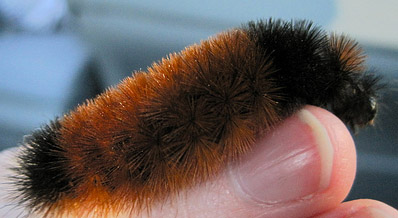
The fuzzy brown and black creature commonly called the woolly worm or woolly bear is the larval form of the tiger moth (Isia isabella). Woolly worms appear in early fall, when they feast on common plants, and emerge in spring from the pupa stage as moths.
North Carolina's Mountain peoples have long relied on the woolly worm's markings to predict the severity of the upcoming winter. The belief that the coloration of the woolly worm's coat matches the harsh and mild periods of the winter has several variations. For instance, the 13 bands on the caterpillar's body, colored brown and black, are said to correspond to the 13 weeks of winter, and the darker a band, the harsher that week will be. Another version holds more generally that a predomination of dark bands means a hard winter, and a majority of brown bands predicts a mild season.
"Reading the worms" is a popular fall pastime in the North Carolina Mountains. Banner Elk hosts an annual Woolly Worm Festival at which the main events are the woolly worm races. Caterpillars race on three-foot strings in heats until a champion is found, and the winning woolly worm is used for the upcoming winter's prediction. The Center for Woolly Worm Studies at Appalachian State University in Boone conducts annual studies on about 500 woolly bear caterpillars in a more scientific attempt to predict the winter weather.